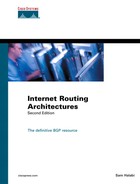The Motivation Behind the New Command-Line Interface
With multiple address families, it was quickly realized that the AF topologies would frequently be noncongruent. Also, policies associated with a given session might vary depending on specific AFs. The initial CLI design focused on accommodating only a single AF (IPv4) and its associated sub-AFs (unicast and multicast). Utilizing this design to provide support for additional AFs introduced unnecessary management and policy expression complexities.
It was therefore decided that a new approach would be used—an approach that cleanly separates general session-related parameters from AF-specific parameters. Beyond management aspects alone, this new approach provides several advantages:
-
Inbound and outbound policy can be different for each AF.
-
A BGP router can be configured as a route reflector for a single AF or multiple AFs.
-
No new configuration is required to support "vanilla" BGP (IPv4-unicast).
-
Prefixes can be sourced (via redistribution, aggregate-address statements, and network statements) within any AF independently.
-
Peer group functionality will be maintained within the associated AF, because it is relevant for UPDATE generation.
This new model is much more flexible when using multiple AFs. Based on the preceding advantages, the router bgp subcommands were divided into three command groups:
-
Commands per-address family— Two sets of commands can be per-AF:
-
Global to per-AF— These commands are neighbor-independent and modify the behavior of BGP for a specific AF. Prefixes to be sourced (using redistribution, network, or aggregate-address statements) under this AF fall into this category. Examples include network 1.2.0.0 mask 255.255.0.0, redistribute dvmrp, and bgp scan-time.
-
AF-specific per-neighbor/peer group— These commands configure policy for the neighbor(s) or peer groups with distribute lists, prefix lists, or route maps. The neighbors can also be configured as clients of a route reflector, or added as members of a peer group. The neighbor must be explicitly "activated" in order to enable the exchange of Multiprotocol BGP prefixes. Examples include neighbor 1.2.3.4 filter-list in, neighbor peergroup1 route-map foo in, and neighbor 1.2.3.4 activate.
-
